Abstract
Anthropogenic activities on soil layers contribute to reworking and eventual modification, which, in most cases, are detrimental to the soil. Going by the significance of soil to life in many ramifications, it is imperative that its consistent assessment enhances and guides management practices. This study focuses on delineating soil structure alterations using ground-penetrating radar (GPR), a geophysical survey method. The principle of operation and the simplicity of the technique have attracted the choice of the non-destructive testing (NDT) method with a view that it could circumvent the drawbacks that characterized the conventional methods hitherto used for such evaluation. Furthermore, the technique allows for the spatial investigation of the concealing sub-layer of the soil and, thus, informs its choice. A test site was selected on a plain farmland in Kraków, Poland, where some parts of the soil structure distortions were induced using tractor movement, which exerted normal stress from the soil surface layer. Subsequently, GPR measurements were acquired via pre-established profiles on the test site, and soil samples were taken for the laboratory evaluation of some of the soil’s physical properties. An analysis of the field data revealed that zones of distorted soil structures have lower attenuation effects on the GPR signal, with corresponding lower amplitude values compared with the unaltered soil structure zones. Evaluated physical properties such as bulk density and state variables like moisture water contents also show a declining trend from the unaltered soil structure zone to the altered zones. The results have revealed characteristic signatures of the zone of soil structure alterations from GPR scanning that can enhance its identification and characterization in the field and, thus, promote decision making toward the effective utilization and management of soil.
1. Introduction
Normal stresses, such as mechanical and hydraulic types that impact soil, could facilitate arrangements of its particles and, at the same time, degrade them. The observation and evaluation of such situations may influence soil management. Attempts have been made in the experiment presented in this report to evaluate, through electromagnetic pulse energy interaction using the ground penetrating radar (GPR), how the soil’s naturally arranged particles are delineated when altered by anthropogenic vertical stress acting on them. The qualitative assessment was supplemented with a laboratory analysis of the physicochemical properties (porosity, bulk density, and moisture content) of samples taken at some selected points in the test area. The expected outcome of the investigation is the test of the usability of the geophysical technique (GPR) adopted in this study to identify deviations in the soil’s void and solid constituent arrangement in a fast, cheap, and repeated way, fostering spatiotemporal variation characterization. The scope of this study is to use the experimental test site as a case study. Thus, the results do not represent the generalization of soil, particularly due to the complexity of the soil media.
Soil grain sizes, which connote its texture and the soil structure, significantly affect water infiltration capacity and storage because these properties promote the reduction in runoff and, thus, increase the amount of water flow to the deeper part of the soil profile [1]. The fertility of the soil and the crop yield from it may be influenced by these soil attributes. Apart from the generic importance of soil, it has also been found that soil plays important roles in the ecosystem, with the capacity to store very large amounts of carbon. For instance, nearly 80 billion Tonnes of carbon have been estimated to reside in European soil [2]. Understanding soil significance may influence its management practices because the degradation of some of its properties may adversely reduce its basic role functions. Soil structure is a physical property that represents the natural arrangement of soil grains into discrete soil units known as aggregates, which may include pores and channels [3]. The aggregate can be in different forms and shapes, ranging from granular to angular to platy. The formation of the soil structure has a significant influence on the porosity of the soil. Hence, pore arrangement enhances the flow of water and air, the germination and growth of plants, and also influences the organisms’ activities within the soil.
Several factors lead to the degradation of soil, particularly as related to macrostructure, which constitutes a major global environmental challenge that these non-renewable resources face. Some studies describe soil alteration processes as having significant impacts on plant growth, leaf area development, biomass yields, and overall crop yields [4]. This is because the dynamic environmental inputs in plant growth, such as water, nutrients, and air, in one way or the other, have direct links with the soil porosity, which relates to the soil structure. Additionally, the physical support provided by soil to plants is huge, shielding them from excessive wind [3]. Thus, soil degradation that may negatively influence its porosity ought to be constantly evaluated to inform a control measure that can be put in place to ameliorate it.
Bronick and Lal [1] concluded in a review that agricultural activities that promote crop yield influence the formation of aggregates in soil and, thus, increase the development of soil structure. Some soil management practices, such as crop rotation, conservation tillage systems, and inoculation, have greatly influenced the soil’s health status through the improvement of the soil structure. Thus, degradations via alterations may hinder the state of the soil [5]. For instance, soil structure degradation has been described as a hindrance to water infiltration, leading to surface water runoff and soil erosion [6,7,8]. Appropriate time intervention in soil health through some indicators, such as the structure status and management practices, is thought to be useful in sustaining long-term soil quality and promoting agricultural sustainability [9]. Plant nutrients necessary for growth are domiciled in the macropores of the soil, facilitated by the soil structure [10]. It has also been established that soil management sustainability increases crop yield and global food supply [11]. The importance of soil on a global scale is increasing. From obtaining alternatives such as biofuel to replacing hydrocarbon fractions that have adverse environmental effects, the quest for its continual assessment, nurturing, and preservation is so important.
The focus of this study is on the soil structure within the surface and near the soil’s surface horizons. The delineation of alteration to the soil structure may foster measures to mitigate it, which may improve the management practices of the soil. The formation of soil structure may be influenced by physicochemical and biological processes. The latter involves flocculation (bonding by clay and organic molecules), while the former involves organisms, organic matter, and tillage practices [3]. Unfortunately, the tillage practices that contribute to the making of the soil may also mar the soil structure in the long run if it is not properly implemented. Thus, the influence of tillage activities is especially important in the management of soil structure. This forms part of the premise on which this study is based. Traditional methods of the identification of alteration in soil structure have largely employed visual observation using soil probes [12], which are discrete and represent laboratory scales. In most cases, the results are usually extrapolated for the spatial evaluation of the area of the target. Hitherto, the systematic characterization of soil structure on a large scale is difficult due to several factors (physical and biological) that control its formation and emplacement [6]. Thus, spatial definition via the conventional methods is cumbersome. The techniques are always associated with drawbacks such as cost and time of execution. However, the present study attempted to utilize a technique that permits the delineation of the alterations in the soil structure via a sensor (geophysical survey technique), thus mitigating some of the drawbacks while promoting repeated assessment and enhancing the measurement of temporal change occurrences. The evaluation of soil alteration zones and their characterization can inform what measures may be taken to improve it for better agricultural practices, which may also be useful as input for precision agriculture.
Since there is a connection between effective porosity and the soil structure distribution [13], better knowledge of the soil structure alteration may be a useful guide for measuring soil response to various tillage methods and management. The use of geophysical techniques in the areas of planning, monitoring, and management of agricultural activities has been evolving in the last few decades. Some of these studies are documented in the reports of Romero-Ruiz et al. [6], Samouelian et al. [14], and Allred et al. [15]. The scientific mapping of soil properties in European Union areas via geophysical datasets has been recorded in the literature [6]. The delineation of the soil structure alteration signature from the GPR data may enhance the appropriate definition of the soil property and, thus, help to decipher its spatial variations. He et al. [16] reported an indirect soil structure evaluation using GPR.
The literature contains few previous efforts at characterizing soil structure using geophysical tools. In most cases, attempts have been made to use various geophysical survey methods to evaluate bulk soil physical properties (e.g., porosity and bulk density) that have a direct relationship with soil structure. However, this approach offers a limited understanding of soil structure due to its dynamic nature [6]. To this end, the attempt made in this report is to investigate the soil structure alteration responses from GPR scanning that may influence spatial characterization, which is a key input in soil utilization and management. Generally, GPR is a non-invasive method of geophysical survey that utilizes electromagnetic energy (EM) pulses that are transmitted through an antenna to the subsurface or media of investigation. The transmitted energy propagates via the media, which may be reflected or refracted at the interface of the contrasting dielectric permittivity (electrical property) material. In the present context, zones of distorted soil structure are presumed to have contrasting electrical properties with the undistorted zones of soil structure.
2. Materials and Methods
Field measurements were made on prepared farmland where the in situ nature of the subsoil and the aggregates are preserved, promoting a study that is devoid of previous anthropogenic influences. The targeted alteration in the soil was achieved by simulating it using tractor movements at several passes on the moderately tilled farmland, where the natural soil particle arrangements are still in place. The tractor has an average weight of about 3000 kg (about 6613.86 lb.), facilitating a relatively deep exertion of normal stress beyond the surface horizon of the soil. The normal stress was induced differentially along different paths from one tractor pass to ten passes across the longitudinal GPR measurement profiles, as illustrated in Figure 1b. The field measurement test site is shown in Figure 1a. A few traverses along the longitudinal axis and also across them were established for the data acquisition, resulting in 13 profiles, as illustrated in Figure 1b. Some soil samples at some points within the test site were also taken for laboratory evaluation on some physical properties for correlation with the geophysical data. GPR geophysical data were acquired using the Mala Pro-Ex unit with an antenna central frequency of 800 MHz, manufactured by MALA Inc., Solna 171 54 Stockholm, Sweden. GPR has been deployed in near-surface investigations in recent years due to its versatility, simplicity of operation, and possibility of real-time interpretation. These attributes and other factors informed the choice of the method for deployment in this study. The GPR technique represents a non-destructive method of investigation that utilizes electromagnetic (EM) waves to capture the image of the subsurface media interactions and the EM energy. The setup of a GPR system consists of three major components: the control unit, the monitor, and the transmitting and receiving antennas. The basics of its operation are that electromagnetic pulse energy is transmitted into the subsurface media, and the corresponding responses in terms of reflections are then measured, which can be viewed simultaneously via the monitor. Details about the principles and techniques of operation are beyond this report and can be found in [17,18,19,20].
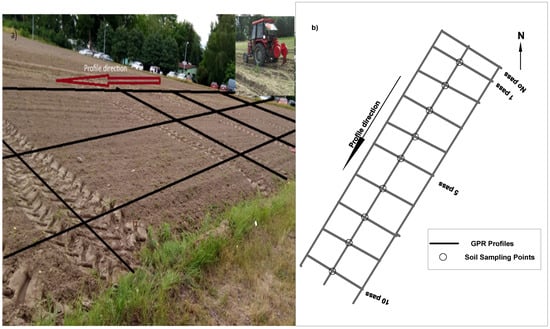
Figure 1.
The study test site. (a) Soil surface induced with normal stress via tractor (inset) movement (black lines are GPR measurement profiles). (b) Illustration of the field measurement profiles.
GPR data are considered non-stationary. This is because GPR field data signals are characterized by sudden drops in the amplitude of the waves and the quick disappearance of the important parts of the frequency harmonics [21], which necessitates post-field-data-acquisition processing.
The field data were analyzed using MATGPR, version 3.1, a GPR data processing software developed by Tzanis [22], and the following processing routines were performed. The fundamentals of the processing modules are briefly highlighted in the subsequent subsections to present why they are usually applied and how they enhance the raw data. The fact that the wrong use of data processing techniques may mar the results of GPR investigations by eliminating targets informed the choice of these basic processing steps. It is important to note that the steps used in the present data processing are not defaults; it all depends on the targets of the investigation, the experience of the investigator, and perhaps the details necessary in the outcome of the investigation.
2.1. Time Zero Correction
Recorded GPR data are usually accompanied by a rise in reflection time, accompanied by the ground surface, which, according to Reynolds [23] and Cassidy and Jol [24], is primarily a result of electronic system effects, the temperature drift of the GPR equipment, and variations in antenna air space. The effect of this rise in reflection is an overestimation of the depth of investigation, which must be removed for an accurate depth to target estimate. Methods of achieving this error correction can be by first break peak, where the EM energy waveform beginning of oscillation is considered, first positive or negative peak, the zero-amplitude spot between the first positive and negative peaks, and the average amplitude spot between the positive and negative peaks [25]. Such corrections are capable of removing the common uniform monochrome layers above the direct signals (air and ground wave) that usually increase the total time window and, thus, the total depth of investigation [20].
2.2. Removal of Low-Frequency Harmonics (De-Wow)
The incorporation of the low-frequency components (the so-called “wow”) in the field of GPR data may be worrisome in some cases because it may obliterate useful information that is inherent in the signal. They are largely caused by the change in time of direct current offset from the antenna that may produce an alteration in trace amplitude [25]. Most de-wow (technique of removal) filter algorithms utilize the moving average mean value method estimated on each trace of the data, which can be deducted from the central point value of the entire dataset [26]. Some alternatives to this could also be the use of a low-pass filter that may suppress the dominant low-frequency harmonics to a specific lower threshold below the Nyquist frequency of the GPR signal. Algorithms implemented via the use of time-varying high-pass filtering and the empirical decomposition methods (EMD) are recorded in the literature to be useful as de-wow filters [27].
2.3. Normalization
The normalization of the trace is a gain filter that enhances the amplitude equality spread in the x-direction via the maximum amplitude of each trace. The filter caters to different sources and receiver coupling effects [26]. According to Bianchini Ciampoli et al. [25], this filter is implemented by multiplying every trace by a ratio between the amplitude of the test site reflection and the amplitude of a reference trace. This implies that each time sample of the individual trace will be multiplied by one scaling factor that is obtained from the total average amplitude of the profile and the highest amplitude of the trace.
2.4. Background Removal
This processing method of the GPR data allows for the removal of unique components of the media of propagation by the electromagnetic waves to reveal inherent anomalies present in the media [20]. The background noise is specifically caused by antenna ringing and the interactions of the GPR system antenna with mobile phones, electricity cables, and other artifacts in the surroundings of the investigation. Essentially, filters utilized to remove such noise are in a two-dimensional form that acts on both the spatial and temporal components of the field data. The filter is implemented by calculating a mean GPR trace from all the traces in the entire GPR section, where it is deducted from every individual trace and sample after sample [25,26]. According to Daniels [17], background removal filters can be expressed mathematically:
where y′(n) and y(n) are the processed and raw signal traces, respectively, with n being the number of the sample and k being the number of the trace within the selected set of traces. Thus, the filter can significantly improve the landscape of raw GPR data and enhance the delineation of hidden information in the application of the filter. It is worth noting that the filter must be used with caution because it may erase particularly important reflections in the recorded data and may also add spurious information in the case of homogeneous non-reflecting media. Therefore, when the target of investigation is the subsurface horizons, extra care must be taken when applying background removal. It works best when the goal of the GPR data is centered on point reflectors. Nevertheless, experienced operators can use it effectively.
2.5. Gain
As mentioned in the preceding subsection, GPR is a non-stationary type of data that has a characteristic rapid reduction in the amplitude values of the propagated electromagnetic waves, and valuable information about the media of propagation attributes may be lost. This situation occurs at a three-dimensional level during field measurements, resulting in a phenomenon called geometrical spreading, where the signals are attenuated due to the dispersive nature of the EM waves [28]. The phenomenon of signal loss may be attributed to the combination of the physical properties of the media, such as electrical conductivity [29], which causes attenuation and scattering effects due to the heterogeneity of the media [25]. There are several gain application methods, but the one utilized for this study was the energy decay function, which can be expressed mathematically as follows:
where y′(n) is the nth sample of the examined trace in the time domain and k is the gain function of the sample number n [29]. By implementing this gain application, a gain curve, usually in the y (time) direction, is introduced to the whole profile by the average amplitude decay curve generated automatically [26]. The time gain application was performed after all the earlier-mentioned processing stages to minimize the amplification of the noise level [26]. As a sequel to the attenuation effects, recorded signals by the receiver do not always correspond to the transmitted pulse signals, and, thus, the propagated media’s deeper information may be suppressed or not captured in the acquired data. Loss due to the attenuation of the transmitted signals is usually compensated for by using the signal gain. In most gain algorithms, the signal gains are time-varying enhancements of the signal amplitudes [25].
2.5.1. Analysis of Signal Attribute (Instantaneous Phase)
Some forms of advanced field data processing were also performed to enhance the subtle inherent information within the propagating media. The GPR signal attributes were calculated using mathematical functions in the algorithms of the software package, which operate on the individual traces and, thus, allow for the estimation of the instantaneous parameters such as the frequency, amplitude, and phase. It is obtained by the Hilbert transform, which allows the filtering function to pass through the amplitude of the spectral components without any interruption but changes the spectral parts’ phases by ninety degrees [30]. According to Barnes [31,32] and Yilmaz [33], if geophysical signals such as GPR and seismic traces can be equated as s(t), and their envelope and phase written as a(t) and ϑ(t), respectively, the following is true.
s(t) = a(t)·cos(ϑ(t))
Similarly, the quadrature (imaginary) trace of the same signal may be written as follows:
then, the complex (analytical) trace z(t) may be denoted by the following equation.
s*(t) = a(t)·sin(ϑ(t))
z(t) = s(t) + i·s*(t) = a(t)·ei·ϑ(t)
From the computation of the complex trace, which has the components of real and imaginary, the instantaneous amplitude a(t) and the phase ϑ(t) can be obtained from Equations (6) and (7), respectively.
a(t) = [s(t)2+ s*(t)2]1/2
The different attributes allow us access to deeper information about the interactions of the propagated EM energy and the media. Instantaneous frequency helps to identify separate reflections that arrive at the same time. The instantaneous phase, emphasized in this report, allows for the delineation of thin layers and trace continuity of reflection [18]. Thus, it could be useful for revealing the zone of alteration in the soil horizons.
It is worth noting that the implementation of the described processing routines may vary from application programs, and yet the purpose of using them is always the same.
2.5.2. Statistical Analysis of GPR Signals
The statistical presentation of the GPR signals has also given more insights into analyzing the raw field data. The sum of the signal absolute amplitude values was computed and plotted against the trace numbers, and, subsequently, the polynomial curve fitting of the plotted data was established to gain a deeper understanding of the information hidden in the data.
2.5.3. Analysis of Soil Samples
Soil samples were taken at designated points within the test site for the laboratory analysis of physical properties such as porosity and bulk density related to the soil particles’ arrangement. The purpose was to investigate the influence of the induced alterations on the physical properties and whether a trend may be linked to the soil structure. The samples were taken along the middle longitudinal profile, which intercepted the zones of altered soil layers at different tractor passes (1 to 10). Both topsoil and subsoil horizons were sampled at 10 cm, 20 cm, and 30 cm depth and were analyzed in the laboratory.
3. Results
3.1. Raw Field Data Analysis
Subsoil horizons in their in situ state are easily discernible, with associated structures delineated as hyperbolas in the GPR scan (Figure 2b). However, the GPR scan on the distorted soil layer region revealed less of the soil subsoil horizon, with an almost completely obliterated structure due to the dearth of multiple hyperbolas on the scan (Figure 2a), particularly in the area of the near-surface that has direct contact with the compaction device (from 0 to 20 cm depth, green rectangle outlines in Figure 2a,b).
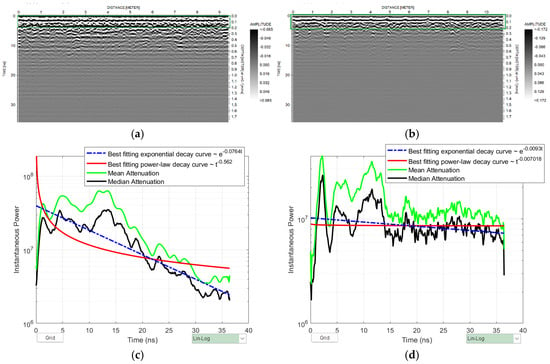
Figure 2.
GPR 2D profile sections and their signal analytic plots; (a) 2D section at the zone of soil alteration and (b) 2D section at the unaltered zone; (c,d) are attenuation attribute plots at both the unaltered and altered zones, respectively.
Both the mean and median attenuation attributes, which are related to the instantaneous power of the GPR-propagated signal, peaked at ~14 ns at the unaltered soil layer (non-compacted) zones (Figure 2c), depicting the possibility of the contrasting dielectric permittivity of the topsoil horizon and the subsoil layer where the mean attenuation begins to decline. However, there is no sharp decline in the average attenuation curve in the GPR profile of the zone of the altered soil layer (Figure 2d), which may be due to the effect of the re-arrangement of the soil structure that merged the upper horizon and the subsoil layer, obliterating the contrast in the dielectric permittivity.
The instantaneous power at the non-compacted zone decreases so sharply at time 15 ns, which may be due to attenuation effects imposed by the constituents (most likely the fluid contents) of the adjacent soil layer (Figure 2c). However, in the compacted zone where soil structure is altered, there is no sharp decline in the instantaneous power (Figure 2d), depicting less attenuation, perhaps due to the expulsion of the fluid contents of the adjacent layer.
As shown in Figure 2c and Figure 2d, respectively, the best exponential decay-fitting curve and power–law decay-fitting curve values for the unaltered soil structure zone (~e−0.07646/~t−0.562) are more than the altered zone (~e−0.0093t/~t−0.007018). It could be interpreted that attenuation is more in the unaltered zone than in the zone of reworked soil structure. Thus, this may be a diagnostic signature of the GPR signal at these different zones.
The instantaneous power function points more to the contrast change in the properties of the propagation medium, perhaps because of the structure alteration caused by the normal stress induced by the tractor’s compaction.
3.2. Instantaneous Phase Results
The continuity of the soil horizons is distorted as revealed by the computation of the instantaneous phase of the 2D GPR sections shown in Figure 3(ai,aii), revealing the rearrangement in the soil layers’ particles due to the effects of the tractor passes. In Figure 3(ai), the in situ particle arrangements are still intact, distinguishing it from areas that have been impacted by the compaction of the tractor passes (Figure 3(aii)) and, thus, may be used to identify such zones in the field.
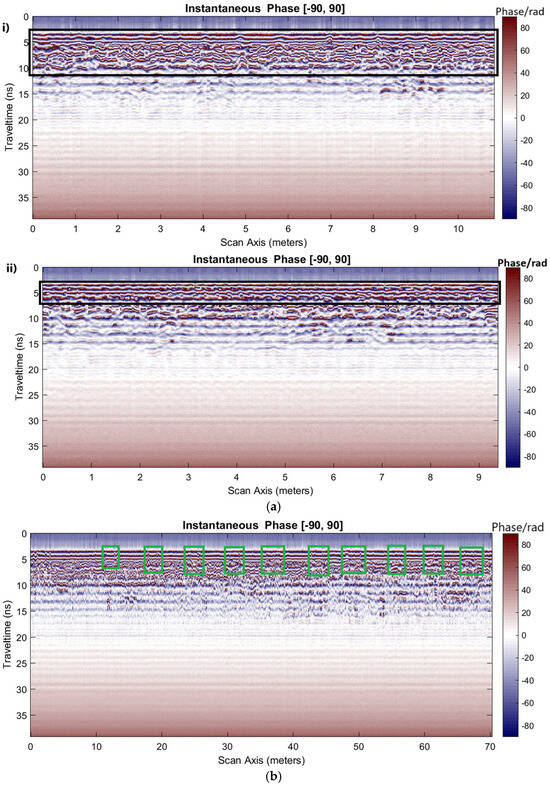
Figure 3.
(a) Instantaneous phase plots; (i) zone of unaltered and (ii) altered soil layer. (b) Instantaneous phase plots along the longitudinal profiles compared with the raw data.
It is observable in Figure 3(aii) (black rectangle outline) that the topsoil horizon is represented as a thin layer almost merging with the subsoil, having been impacted by equal normal stress from the tractor, which may have disintegrated the soil structure.
Similarly, on one of the GPR longitudinal profiles where the soil alteration paths are intercepted (Figure 3b), the effect of the distortions caused by the normal stress from the tractor passes on the soil is discernible (green rectangular outlines). The subsoil layer continuity is distorted, purporting the effect of the reworked soil structure. The GPR signal instantaneous attributes are best computed from the unprocessed raw data, which is why the depth conversion was not made on the plot, but rather, the time travel time plot in nanoseconds was used.
3.3. Signal Amplitude Value Statistical Analysis
The sum of absolute amplitude values was computed from the GPR signals on one of the longitudinal profiles that intercepted the compacted soil zones and then plotted based on the trace number (Figure 4). The figures show the area plot, which allows for delineating trends and deviations in the plotted data. The amplitude values examined on the profile are those within the uppermost horizon (time: 0–5 ns) and on the profile distance from 5.5 m to 40 m (inset Figure 4, yellow rectangle line). The zones of altered soil structure because of the normal stress induced by the tractor passes are easily discernible, showing significant contrasting values (less than 150,000, inverted arrows in Figure 4). The decline in the values at these zones may be attributed to change caused by the loss of the soil structure, which hosts the fluid contents that influence the dielectric permittivity of the media that controls the reflectivity, as revealed in the signal’s amplitude.
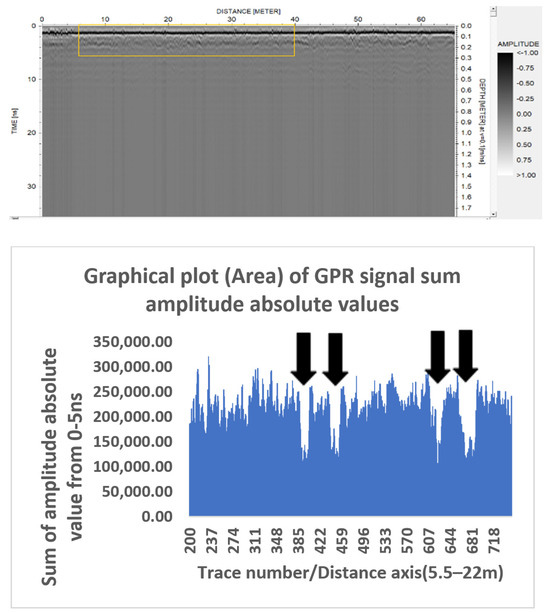
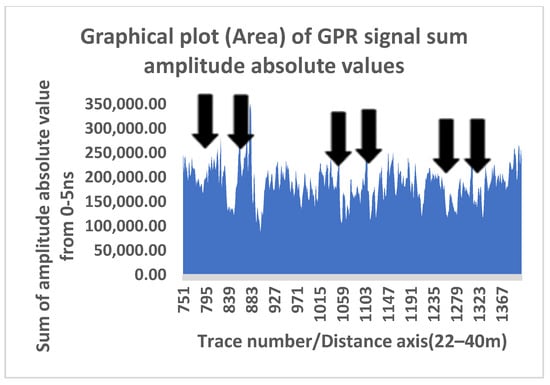
Figure 4.
GPR signal sum of absolute amplitude value plots along a longitudinal profile (from part of the unaltered soil zone to part of the altered zone). The inset represents the plotted zone marked within the yellow rectangle.
In the same vein, computed sum absolute amplitude values on two adjacent GPR profiles, with one profile each from both distorted and undistorted zones, were plotted. The plotted curves in the two different scenarios were curve-fitted using the polynomial method, and the results gave an insight into the GPR signal responses. The sixth-degree polynomial fitted curve predicted higher amplitude values on the undistorted profile (Figure 5a) than the profile where normal stress was induced on the soil (Figure 5b). It can be deduced that signal reflectivity declined from ~200,000 to 150,000 in the two scenarios, respectively could be as a result of the alteration in the soil structure.
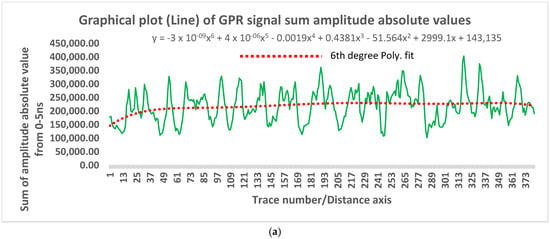
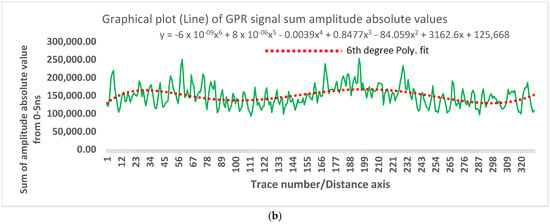
Figure 5.
GPR signal sum of absolute amplitude value plots on two adjacent profiles: (a) for a profile on the unaltered zone and (b) for a profile on the altered zone.
The higher signal amplitude values at the undistorted zone, as expected, may be due to the contrasting dielectric permittivity with the altered zone induced by the influence of the soil structure alteration.
3.4. Soil Sample Analysis Results
The trend from the plots of the different evaluated parameters from the laboratory analysis of the soil samples collected at the various zones of distorted and undistorted zones is shown in Figure 6a–c. The bulk density increases with an increase in the amount of the exerted normal stress by the tractor passes at the different depths sampled (Figure 6a). There is also a decline in the moisture content from the surface horizon to the subsoil, as shown in Figure 6b. In the porosity estimation plot (Figure 6c), a trend in the surface horizon (depth 0–10 cm) depicts a decline from the unaltered soil zone to the zone with the highest compacted force. No trend is observable in the subsoil layers, which may be due to the minimal effect of the compaction on the deeper soil horizons. The loss of sampled data at a depth of 30 cm at the tractor’s 10 passes caused the dearth of information on the tail ends of plots in Figure 6a–c. Nevertheless, available data depict the trends.
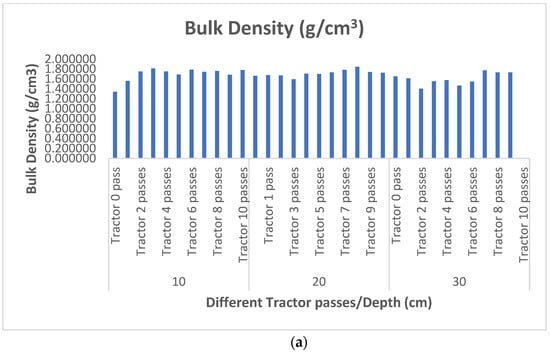
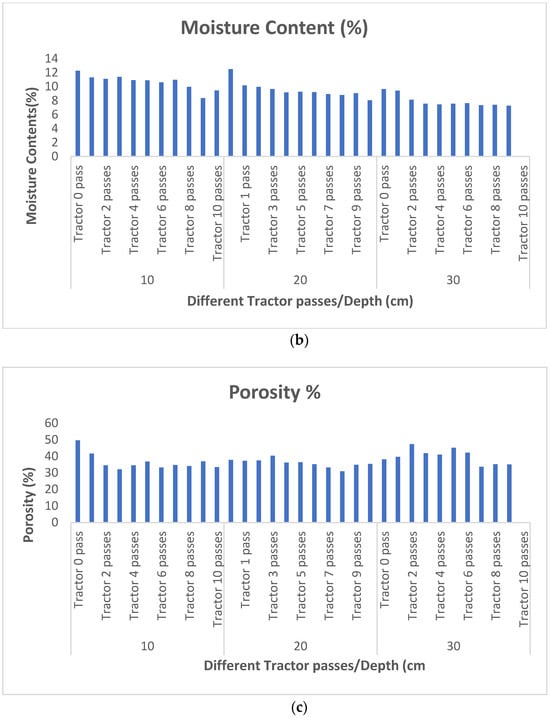
Figure 6.
Statistical column plot of laboratory-measured soil properties at different depths and compacted effects. (a) Bulk density. (b) Moisture content. (c) Porosity.
4. Discussion
Analysis of the various field data after processing and transformation has shown that the soil structures’ alteration zones have characteristics and signatures that can be depicted from field-measured ground-penetrating radar data. In the simplest field data results, the zones are depicted as areas with dearth or obliterated hyperbola diffraction, as seen in Figure 2a,b. Further probes using the attenuation characteristics also revealed significant discrepancies in the zone of distorted and undistorted soil structure (Figure 2c,d). A plausible explanation is that the high attenuation attributed to the unaltered soil structure zone may mean that the porosity, which is influenced by the structure, may have enhanced increase in the fluid content, which is one of the factors that dictates EM wave energy attenuation.
The computed GPR signal attributes also allow for a better understanding of the continuity of the layers within both the unaltered and altered soil structure zones, as presented in Figure 3a,b. It is shown that the instantaneous phase distinguishes the distorted soil zone due to altered soil structure and zones without any impacted normal stress and, thus, may facilitate the mapping and characterization of the zones.
Attempts to obtain more characteristic information about the interaction between the propagated GPR signals with the media around the distorted and undistorted soil zones led to the statistical plotting of the sum absolute amplitude value of the GPR signal of some parts of the 2D sections. The plots facilitated the identification of the altered regions within the section as having relatively low amplitude values as compared to the unaltered regions, which may be explained by the difference in the constituent properties of the two regions. A step further, fitting the sum absolute amplitude value plots on two adjacent profiles (altered and unaltered zones) [Figure 5a,b] also gave credence to distinguishing them. The unaltered zone has relatively higher amplitude values than the altered zone, which may be attributed to the soil structure distortions that influence the factors that control the reflectivity of the propagated EM pulse energy.
To complement the geophysical field data interpretations, the sampled soil specimens at different depths within the test site were also analyzed and presented. The results also show trends that supported the various analyzed GPR data interpretations. For instance, the soil moisture contents tend to decline from the unaltered zone to the zone with maximum compacted impact on the surface horizon (Figure 6b). This is thought to be because of the reworked soil structures at the distorted zones, which may have caused a loss of fluid contents within the zone and, thus, influenced the media interaction with the GPR EM propagated energy. This relationship may be a diagnostic feature that may allow for the delineation of zones of altered soil structure, which may inform the useful implementation of soil utilization and management policy.
5. Conclusions
The objective of the present study is to unravel the possibility of analyzing the effects of soil structure distortions from ground-penetrating radar scanning responses vis-à-vis its characterization, which may inform optimum soil utilization and management. To this effect, normal stress was induced in some parts of the test sites using varying passes of a known-weight tractor while GPR scanning measurements were taken along a pre-established transect both across and along the induced normal stress on the soil. Analyses of the acquired data, coupled with the laboratory estimation of some physical properties from some selected samples, have shown that soil structure alterations and their effects on the general management of the soil can be investigated using the GPR dataset. Soil structure distortion inflicts significant adverse effects on the soil, preventing it from maximizing its potential. For instance, soil structure alteration may hinder appropriate aeration and water infiltration in the soil.
In the zones of soil structure alterations, the GPR signal amplitude values decrease, which may be attributed to changes in the media constituent properties as confirmed by the analyzed soil samples at these zones. The discrepancy in the mean attenuation of the GPR signals is another characteristic signature that may be attributed to the soil structure distortion, which could be explained by the changes in the media’s physical properties and complemented by the soil sample analysis results. The swiftness of the GPR techniques and their simplicity allow for possible repeated measurements for such soil evaluation. Reports of such an evaluation may provide vital information on soil utilization and management if available to stakeholders in the sector, particularly when considering precision agriculture practices, and, importantly, when real-time and temporal variation data are sought. The technique (GPR) utilized in this study is without prejudice to the conventional methods of evaluation, rather, it could be a leverage to them. It is worth noting that the adopted method of study is not without some limitations, particularly the attenuation of GPR signals in highly conductive media. Thus, the method may not be effective in waterlogged areas and soils of very high clay content.
Funding
Financed by a subsidy from the Ministry of Education and Science for the Hugo Kołłątaj University of Agriculture in Cracow for 2025.
Institutional Review Board Statement
Not applicable.
Informed Consent Statement
Not applicable.
Data Availability Statement
Data will be made available on request.
Conflicts of Interest
The author declares no conflicts of interest.
References
- Bronick, C.J.; Lal, R. Soil structure and management: A review. Geoderma 2005, 124, 3–22. [Google Scholar] [CrossRef]
- Emmet-Booth, J.P.; Forristal, P.D.; Fenton, O.; Bondil, G.; Wall, D.P.; Creamer, R.E.; Hofden, N.M. The Soil Structure ABC, A Practical Guide to Managing Soil Structure. 2018. Available online: https://www.teagasc.ie/media/website/environment/soil/The-soil-structure-ABC.-A-practical-guide-to-managing-soil-structure.pdf (accessed on 3 October 2024).
- Weil, R.R.; Brady, N.C.; Weil, R.R. The Nature and Properties of Soils; Pearson: London, UK, 2017. [Google Scholar]
- Pagliai, M.; Vignozzi, N.; Pellegrini, S. Soil structure and the effect of management practices. Soil Tillage Res. 2004, 79, 131–143. [Google Scholar] [CrossRef]
- Njira, K.O.; Nabwami, J. Soil management practices that improve soil health: Elucidating their implications on biological indicators. J. Anim. Plant Sci. 2013, 18, 2750–2760. [Google Scholar]
- Romero-Ruiz, A.; Linde, N.; Keller, T.; Or, D. A review of geophysical methods for soil structure characterization. Rev. Geophys. 2018, 56, 672–697. [Google Scholar] [CrossRef]
- Nawaz, M.F.; Bourrie, G.; Trolard, F. Soil compaction impact and modelling. A review. Agron. Sustain. Dev. 2013, 33, 291–309. [Google Scholar] [CrossRef]
- Chen, Y.L.; Palta, J.; Clements, J.; Buirchell, B.; Siddique, K.H.; Rengel, Z. Root architecture alteration of narrow-leafed lupin and wheat in response to soil compaction. Field Crops Res. 2014, 165, 61–70. [Google Scholar] [CrossRef]
- Ernest, H.; Kumar, A.; Bhople, B.S.; Srivastava, P.K.; Singh, R.D.; Sahu, S.K. Soil quality and health management through farming practices: To ensure agricultural sustainability. Res. J. Pharm. Biol. Chem. Sci. 2015, 6, 1983–1992. [Google Scholar]
- Dogra, P.; Jat, M.K.; Parashar, A.; Yadav, V.P. Strategies for Survival and Increasing Microbial Population of Biofertilizers in Soil. 2021. Available online: https://www.researchgate.net/publication/349287334_Strategies_for_Survival_and_increasing_Microbial_Population_of_Biofertilizers_in_Soil (accessed on 15 September 2024).
- Meena, M.; Hemavarshini, M.P.; Dharuman, R.; Nath, D. Soil Management and Sustainable Agriculture. In Advances in Soil Science Volume—1; Bright Sky Publications: Delhi, India, 2023. [Google Scholar] [CrossRef]
- Guimarães, R.M.; Lamandé, M.; Munkholm, L.J.; Ball, B.C.; Keller, T. Opportunities and future directions for visual soil evaluation methods in soil structure research. Soil Tillage Res. 2017, 173, 104–113. [Google Scholar] [CrossRef]
- Hao, X.; Ball, B.C.; Culley, J.L.; Carter, M.R.; Parkin, G.W. Soil density and porosity. Soil Sampl. Methods Anal. 2008, 2, 743–759. [Google Scholar]
- Samouëlian, A.; Cousin, I.; Tabbagh, A.; Bruand, A.; Richard, G. Electrical resistivity survey in soil science: A review. Soil Tillage Res. 2005, 83, 173–193. [Google Scholar] [CrossRef]
- Allred, B.; Daniels, J.J.; Ehsani, M.R. Handbook of Agricultural Geophysics; CRC Press: Boca Raton, FL, USA, 2008; Available online: https://library.seg.org/doi/pdf/10.4133/SAGEEP.29-001 (accessed on 21 August 2024).
- He, Y.; Fang, L.; Peng, S.; Liu, W.; Cui, C. A Ground-Penetrating Radar-Based Study of the Structure and Moisture Content of Complex Reconfigured Soils. Water 2024, 16, 2332. [Google Scholar] [CrossRef]
- Daniels, D.J. (Ed.) Ground Penetrating Radar; The Institution of Electrical Engineers: London, UK, 2004. [Google Scholar]
- Annan, P. Ground Penetrating Radar Principles, Procedures and Applications; Sensors & Software Inc.: Mississauga, ON, USA, 2003; p. 278. [Google Scholar]
- Jol, H.M. (Ed.) Ground Penetrating Radar Theory and Applications; Elsevier: Amsterdam, The Netherlands, 2008. [Google Scholar]
- Utsi, E.C. Ground Penetrating Radar: Theory and Practice; Butterworth-Heinemann: Oxford, UK, 2017. [Google Scholar]
- Economou, N.; Benedetto, F.; Bano, M.; Tzanis, A.; Nyquist, J.; Sandmeier, K.J.; Cassidy, N. Advanced ground penetrating radar signal processing techniques. Signal Process. 2017, 132, 197–200. [Google Scholar] [CrossRef]
- Tzanis, A. MATGPR: A freeware MATLAB package for the analysis of common-offset GPR data. Geophys. Res. Abstr. 2006, 8, 09488. [Google Scholar]
- Reynolds, J.M. An Introduction to Applied and Environmental Geophysics; John Wiley & Sons: Hoboken, NJ, USA, 2011. [Google Scholar]
- Cassidy, N.J. Ground penetrating radar data processing, modelling and analysis. Ground Penetrating Radar Theory Appl. 2009, 2009, 141–176. [Google Scholar] [CrossRef]
- Bianchini Ciampoli, L.; Tosti, F.; Economou, N.; Benedetto, F. Signal processing of GPR data for road surveys. Geosciences 2019, 9, 96. [Google Scholar] [CrossRef]
- Sandmeier, K.J. Manual Document for Reflexw Program for the Processing of Seismic, Acoustic and Electromagnetic Reflection and Transmission Data; Sandmeier Geophysical Research: Karlsruhe, Germany, 2012. [Google Scholar]
- Battista, B.M.; Addison, A.D.; Knapp, C.C. Empirical mode decomposition operator for dewowing GPR data. J. Environ. Eng. Geophys. 2009, 14, 163–169. [Google Scholar] [CrossRef]
- Davis, J.L.; Annan, A.P. Ground-penetrating radar for high-resolution mapping of soil and rock stratigraphy 1. Geophys. Prospect. 1989, 37, 531–551. [Google Scholar] [CrossRef]
- Benedetto, A.; Tosti, F.; Ciampoli, L.B.; D’amico, F. An overview of ground-penetrating radar signal processing techniques for road inspections. Signal Process. 2017, 132, 201–209. [Google Scholar] [CrossRef]
- Ofuyah, W.; Orji, O.; Eze, S. The Application of Spectral Decomposition to 3-D Seismic Data over ‘X’-Oil Field, Niger Delta. Geosciences 2015, 5, 86–99. [Google Scholar]
- Barnes, A.E. Instantaneous frequency and amplitude at the envelope peak of a constant-phase wavelet. Geophysics 1991, 56, 1058–1060. [Google Scholar] [CrossRef]
- Barnes, A.E. A tutorial on complex seismic trace analysis. Geophysics 2007, 72, W33–W43. [Google Scholar] [CrossRef]
- Yilmaz, Ö. Seismic Data Analysis: Processing, Inversion, and Interpretation of Seismic Data; Society of Exploration Geophysicists: Houston, TX, USA, 2001. [Google Scholar] [CrossRef]
Disclaimer/Publisher’s Note: The statements, opinions and data contained in all publications are solely those of the individual author(s) and contributor(s) and not of MDPI and/or the editor(s). MDPI and/or the editor(s) disclaim responsibility for any injury to people or property resulting from any ideas, methods, instructions or products referred to in the content. |
© 2025 by the author. Licensee MDPI, Basel, Switzerland. This article is an open access article distributed under the terms and conditions of the Creative Commons Attribution (CC BY) license (https://creativecommons.org/licenses/by/4.0/).